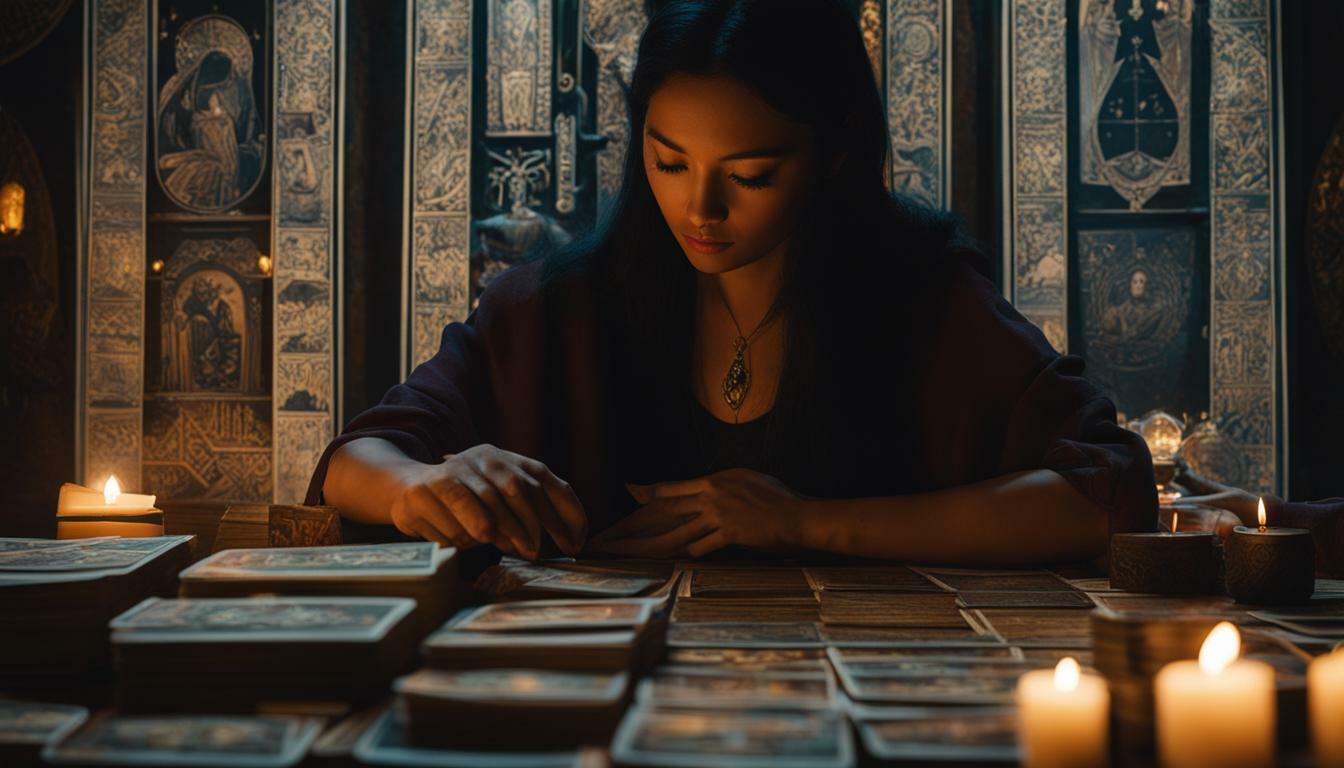Are you ready to embark on an intriguing journey of divination and unlock the secrets of the tarot?
Tarot reading can be a powerful tool for self-discovery and guidance, and anyone can learn to read tarot cards. A standard tarot deck consists of 78 cards, divided into the major arcana and minor arcana. The major arcana contains 22 cards that represent major life events and themes, while the minor arcana consists of four suits (cups, wands, swords, and pentacles) that relate to day-to-day challenges.
To begin your first tarot reading, you’ll need a deck of tarot cards and a willingness to learn. There are various tarot spreads you can use, such as the one-card spread, the three-card spread (representing past, present, and future), the five-card spread (providing deeper insight), and the Celtic cross spread (a complex spread for in-depth readings).
When pulling a card, rely on your intuition and choose a method that feels right for you, whether it’s shuffling the deck or utilizing a specific card placement. Before using your tarot deck, it’s recommended to clear or cleanse it by using crystals, sage, or palo santo.
Additionally, there are tarot decks with different styles and symbolism to choose from, including popular ones like Rider-Waite Smith and Crowley-Harris Thoth. It’s important to familiarize yourself with the meanings of the tarot cards, either through the guidebook that comes with the deck or by researching online.
Finally, always set your intention before a reading and reflect on the cards’ messages to gain insights and guidance. Remember, reading tarot cards can be a personal and transformative experience, so enjoy the journey of unfolding the mysteries they hold.
Key Takeaways:
- Tarot reading is a tool for self-discovery and guidance.
- A standard tarot deck consists of 78 cards divided into major and minor arcana.
- Various tarot spreads, such as the one-card spread and the Celtic cross spread, can be used for readings.
- Trust your intuition when pulling a card and choose a method that feels right for you.
- Clearing or cleansing your tarot deck before use is recommended.
The Basics of Tarot Reading
Before diving into your first tarot reading, it’s essential to familiarize yourself with the basics of this ancient art form. Tarot reading can be a powerful tool for self-discovery and guidance, and anyone can learn to read tarot cards. A standard tarot deck consists of 78 cards, divided into the major arcana and minor arcana. The major arcana contains 22 cards that represent major life events and themes, while the minor arcana consists of four suits (cups, wands, swords, and pentacles) that relate to day-to-day challenges.
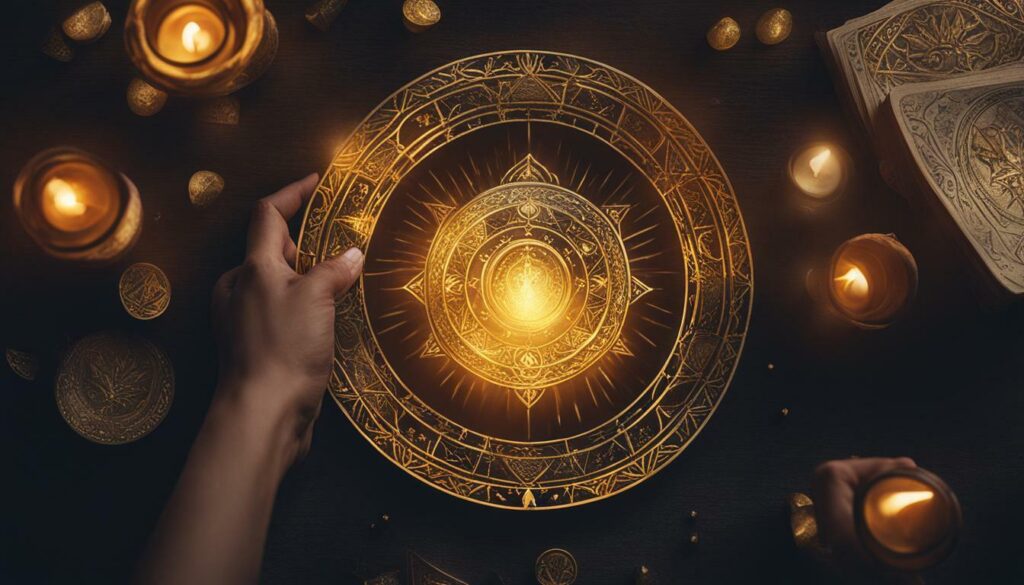
When starting your tarot reading journey, it’s important to choose a deck that resonates with you. There are various tarot decks available, each with its own unique style and symbolism. Popular decks like the Rider-Waite Smith and Crowley-Harris Thoth have become widely recognized and widely used. Take the time to explore different decks and choose the one that speaks to you personally, as this will enhance your connection with the cards and your readings.
To begin your first tarot reading, you’ll need a deck of tarot cards and a willingness to learn. There are various tarot spreads you can use, such as the one-card spread, the three-card spread representing past, present, and future, the five-card spread providing deeper insight, and the Celtic cross spread for in-depth readings. When pulling a card, rely on your intuition and choose a method that feels right for you, whether it’s shuffling the deck or utilizing a specific card placement.
Before using your tarot deck, it’s recommended to clear or cleanse it. This can be done using crystals, sage, or palo santo. Cleansing your deck helps to remove any residual energy and ensures a fresh start for your readings. Additionally, it’s important to familiarize yourself with the meanings of the tarot cards. This can be done through the guidebook that comes with the deck or by researching online resources. Take the time to study and understand the symbolism of each card, as this will enrich your interpretations and enable you to provide more accurate readings.
Choosing the Right Tarot Deck for Beginners
With so many tarot decks to choose from, finding the right one for beginners can be overwhelming, but fear not – we’re here to guide you in making the perfect choice. When starting your tarot journey, it’s essential to select a deck that resonates with you on a personal level.
One popular option for beginners is the Rider-Waite Smith deck, which features traditional imagery and a comprehensive guidebook that explains each card’s meaning. This deck is widely used and offers a solid foundation for learning tarot. Another well-regarded deck is the Crowley-Harris Thoth deck, renowned for its rich symbolism and intricate artwork.
When choosing a deck, consider your preferences in terms of artistic style, symbolism, and theme. Take time to browse through different decks and connect with the images and energy they evoke. You may find it helpful to visit a local metaphysical store or explore online resources that offer detailed images and descriptions of various tarot decks.
Remember, the most important factor is choosing a deck that speaks to you personally. Trust your intuition and allow yourself to be drawn to the deck that resonates with your heart and soul. Once you find the perfect deck, you’ll be ready to embark on a transformative journey of self-discovery and guidance.
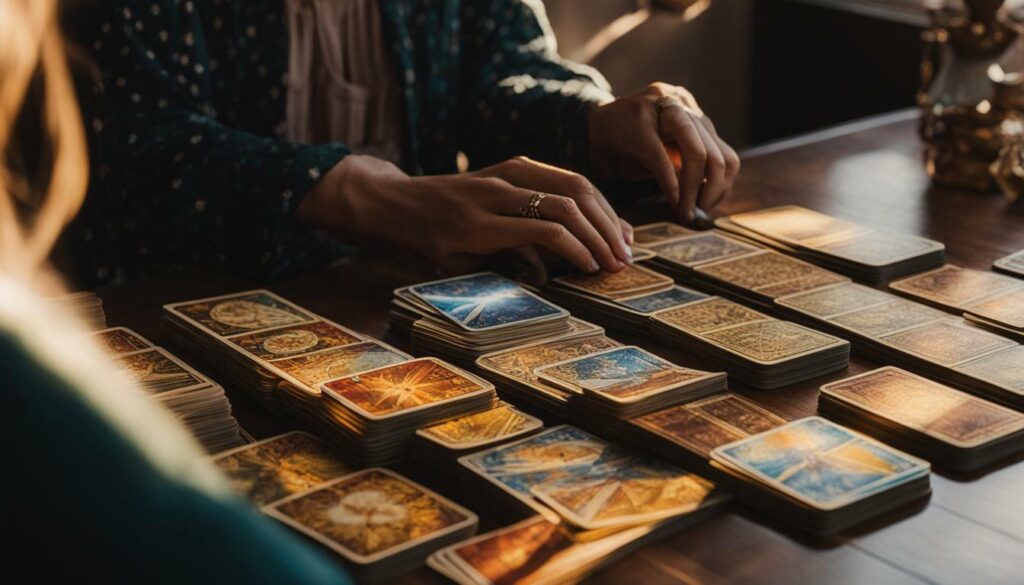
Recommended Tarot Decks for Beginners:
| Deck Name | Artistic Style | Symbolism |
|---|---|---|
| Rider-Waite Smith | Traditional | Clear and easily interpretable |
| Crowley-Harris Thoth | Intricate and mystical | Deep esoteric symbolism |
| Shadowscapes | Fantasy and whimsical | Nature-inspired symbolism |
| The Wild Unknown | Minimalistic and abstract | Emphasizes intuitive interpretation |
These are just a few examples of tarot decks suitable for beginners. Remember to explore different options and choose the one that resonates with you the most. Your tarot deck should be a personal reflection of your journey and a tool that assists you in connecting with your intuition.
Understanding the Symbolism of Tarot Cards
Tarot cards are rich in symbolism, and understanding the messages they convey is key to unlocking their wisdom. Each card contains a unique combination of symbols, colors, and imagery that carries specific meanings and insights. By delving into the symbolism of tarot cards, you can gain a deeper understanding of their significance and interpret their messages with greater clarity.
When exploring the symbolism of tarot cards, it’s important to consider both individual card meanings and the connections between cards within a spread. The major arcana cards, for example, represent significant life events and archetypal themes, while the minor arcana cards reflect day-to-day challenges and experiences.
One way to approach the symbolism of tarot cards is to engage in visual analysis. Take note of the colors, objects, and figures depicted on each card. Consider the emotions they evoke and the stories they tell. For example, the Chariot card often features a figure driving a chariot pulled by two contrasting animals, representing the need to find balance and harness opposing forces.
| Card | Symbolism | Meaning |
|---|---|---|
| The Fool | White rose, dog, cliff | Urges you to embrace new beginnings and take risks |
| The Empress | Wheat, crown, heart | Represents abundance, fertility, and nurturing energy |
| The Tower | Lightning, crumbling tower, falling figures | Symbolizes sudden change, destruction, and upheaval |
Remember, while there are traditional interpretations for each card, it’s important to trust your intuition and personal impressions when interpreting tarot symbolism. Your connection to the cards and your own life experiences will bring unique insights to your readings. As you deepen your understanding of tarot symbolism, you’ll unlock the true power and wisdom that these cards hold.
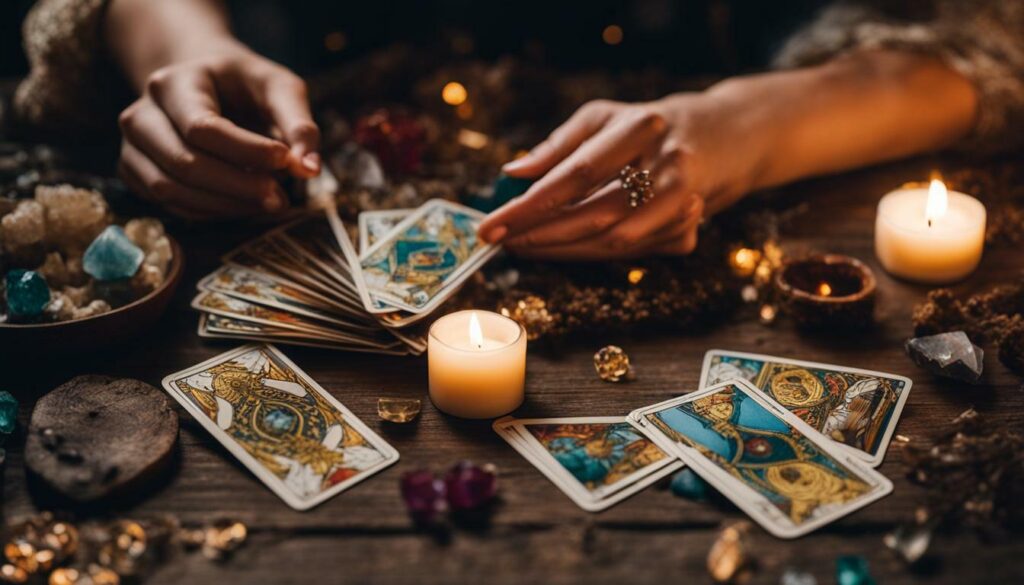
Preparing for Your First Tarot Reading
Setting the stage for your tarot reading is essential to create a sacred and focused environment. Before diving into the mystical realm of tarot, take a moment to prepare both yourself and your space. Begin by finding a quiet and comfortable area where you can focus without distractions. This can be a cozy corner of your home, a peaceful garden, or even a serene park. Creating a calm atmosphere will help you connect with your intuition and the energy of the cards.
To enhance the ambiance, consider lighting a candle or burning some incense. This can help to cleanse the space and create a tranquil atmosphere. You may also want to play soft background music to further set the mood. Experiment with different genres, such as soothing instrumental melodies or gentle nature sounds, and choose whatever resonates with you.
Before you begin, take a moment to ground yourself. Close your eyes, take a few deep breaths, and visualize roots growing from the soles of your feet, anchoring you to the earth. This simple grounding exercise will help you feel more centered and present, allowing your intuition to flow freely during the reading.
| Preparation Tips for Your First Tarot Reading: |
|---|
| Find a quiet and comfortable space free from distractions. |
| Light a candle or burn incense to create a sacred atmosphere. |
| Play soft and calming music to enhance the mood. |
| Ground yourself through deep breathing and visualization. |
Remember, the key to a successful tarot reading is to trust your intuition and let it guide you. The cards are merely a tool to unlock your inner wisdom and provide insights into your current situation. Approach your first tarot reading with an open mind and a willingness to learn, and you’ll embark on a fascinating journey of self-discovery and personal growth.
Now that you have set the stage for your first tarot reading, it’s time to delve into the beautiful and mysterious world of the tarot cards. In the next section, we will explore the meanings and symbolism behind the cards, helping you to unlock their hidden messages and gain a deeper understanding of the readings.
Next Steps: Exploring Tarot Card Meanings
Getting Familiar with Tarot Card Meanings
As a beginner, it’s crucial to familiarize yourself with the meanings of the tarot cards to interpret their messages accurately. A standard tarot deck consists of 78 cards, divided into the major arcana and minor arcana. The major arcana represents major life events and themes, while the minor arcana relates to day-to-day challenges and is divided into four suits: cups, wands, swords, and pentacles.
To start your journey, it’s recommended to use the guidebook that comes with your tarot deck. This guidebook provides detailed explanations of each card’s meaning and symbolism. Take the time to read and study each card, allowing yourself to connect with the imagery and symbolism. Additionally, there are numerous online resources and books available that can provide further insights into the tarot card meanings.
Remember, each card holds multiple layers of interpretation, and it’s important to approach them with an open mind and trust your intuition. The meanings of the cards can also evolve and change as you deepen your understanding of tarot.
As you become more comfortable with the basic meanings of the cards, you can start exploring the connections between them. Pay attention to the cards’ placements in your chosen tarot spreads and how they interact with each other. This will allow you to tell a cohesive story and provide more insightful readings.
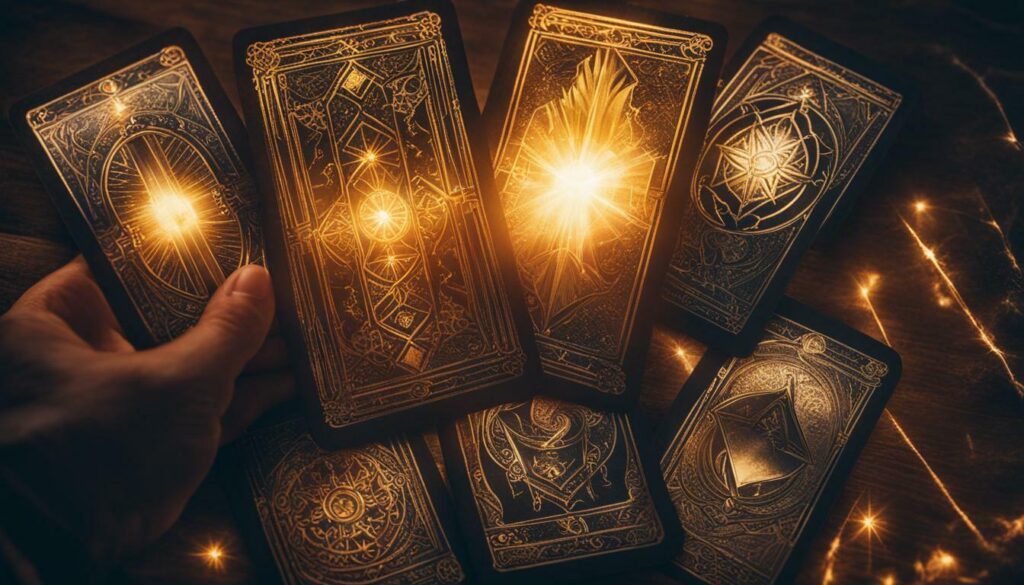
Example Table:
| Card | Meaning |
|---|---|
| The Fool | Beginnings, spontaneity, innocence |
| The Magician | Manifestation, power, resourcefulness |
| The High Priestess | Intuition, wisdom, mystery |
| The Empress | Fertility, abundance, nurturing |
By familiarizing yourself with the meanings of the tarot cards, you’ll be able to tap into their wisdom and guidance. Remember that interpretation is subjective, and it’s important to trust your instincts as you explore the world of tarot. Enjoy the journey of unlocking the mysteries and discovering the transformative power of tarot reading.
Exploring Common Tarot Spreads for Beginners
Tarot spreads provide a structured layout for arranging and interpreting the cards, giving you deeper insight into specific questions or situations. As a beginner, it’s helpful to start with simple spreads that provide clear guidance. One of the most popular spreads for beginners is the one-card spread. This straightforward layout involves drawing a single card and focusing on its meaning and message. It’s a great way to get comfortable with interpreting individual cards and their significance.
Another common spread for beginners is the three-card spread. This spread represents the past, present, and future, offering a comprehensive view of a situation. The first card signifies the past, providing insights into past events or influences. The second card represents the present, shedding light on current circumstances. The third card represents the future, offering guidance and potential outcomes. The three-card spread helps you understand the flow of energy and how it relates to your query.
If you’re seeking deeper insights, the five-card spread is a fantastic option. This spread provides more in-depth information and allows for a multifaceted approach to your inquiry. Each card in the spread has a specific position and meaning, providing a comprehensive analysis of the situation at hand. The five-card spread can reveal underlying factors, obstacles, and potential outcomes, giving you a holistic understanding of the topic.
The Celtic cross spread is a more complex layout typically used for in-depth readings. It consists of ten cards, each representing different aspects of your life or the situation you’re exploring. Each position relates to a specific theme, such as the past, present, future, and external influences. The Celtic cross spread offers a detailed and nuanced view of your query, allowing you to explore different perspectives and gain deeper insights.
| Spread Name | Card Count | Description |
|---|---|---|
| One-Card Spread | 1 | A single card that offers insight into a specific question or situation. |
| Three-Card Spread | 3 | Representing the past, present, and future, this spread provides a comprehensive view of a situation. |
| Five-Card Spread | 5 | A more in-depth spread that offers deeper insights into the topic at hand. |
| Celtic Cross Spread | 10 | A complex and comprehensive spread that examines different aspects of your life or situation. |
Remember, when performing a tarot reading, it’s important to trust your intuition and personalize the spreads to suit your needs. Experiment with different layouts and find the ones that resonate with you the most. With practice and a curious mind, tarot spreads can become a valuable tool for self-discovery and guidance.
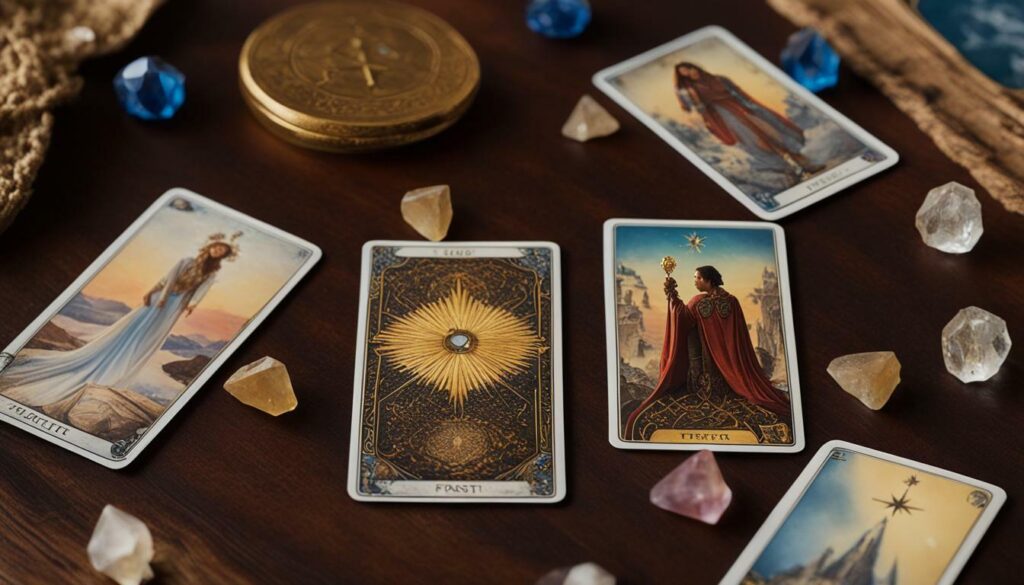
Step-by-Step Tarot Reading Tutorial
Embark on your first tarot reading journey with this comprehensive step-by-step tutorial. Tarot reading can be a powerful tool for self-discovery and guidance, and with a little practice, anyone can learn to read tarot cards. So, let’s dive in and explore the fascinating world of tarot!
Step 1: Select Your Tarot Deck
Before you begin, choose a tarot deck that resonates with you. Popular options for beginners include the Rider-Waite Smith deck and the Crowley-Harris Thoth deck. Each deck has its own unique symbolism and style, so take your time to find the one that speaks to you.
Step 2: Cleanse and Set Your Intention
Before using your tarot deck, it’s essential to cleanse and clear any lingering energies. You can do this by placing your deck under moonlight, using crystals, or smudging with sage or palo santo. As you cleanse your deck, set your intention for the reading, asking for guidance and clarity.
Step 3: Shuffle and Pull Cards
Once your deck is cleansed and your intention is set, shuffle the cards while focusing on your question or the area of your life you want guidance on. When you feel ready, stop shuffling and cut the deck. Now, start pulling cards for your chosen spread, whether it’s a simple one-card reading or a more complex spread like the Celtic cross.
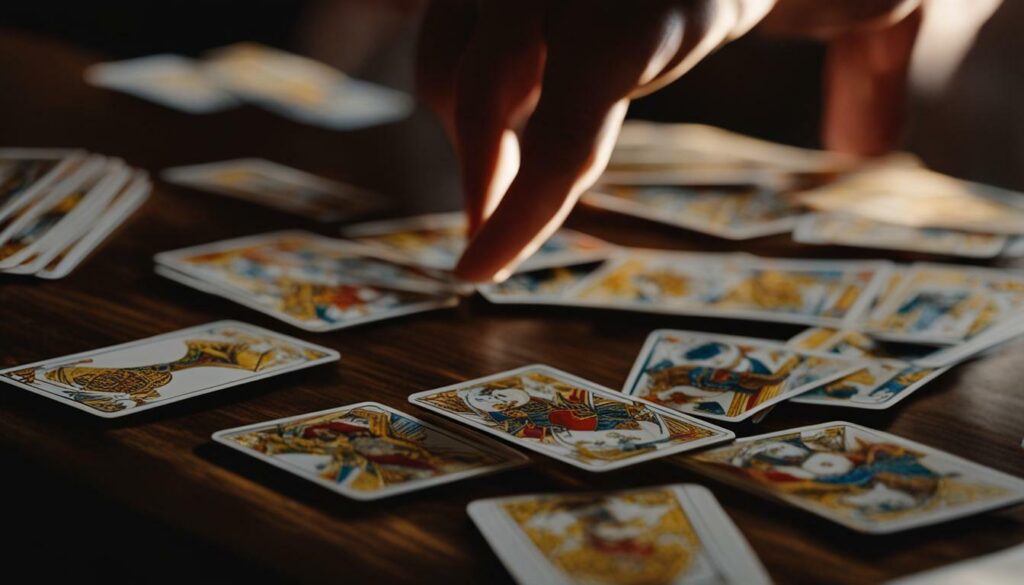
Step 4: Interpret the Cards
As you reveal each card, pay attention to your intuition and the symbols depicted. Refer to the guidebook that comes with your deck or explore online resources to understand the meanings of the cards. Remember that interpretation is subjective, so trust your instincts and connect the cards’ messages to your own situation.
By following these steps, you’ll be well on your way to conducting insightful and meaningful tarot readings. Remember, tarot reading is a personal journey, and practice is key to developing your skills. So embrace the mysteries of the cards and enjoy the transformative experience that tarot has to offer!
Cleansing and Clearing Your Tarot Deck
Purifying your tarot deck is crucial to ensure accurate and untainted readings. It allows you to clear any residual energies and establish a connection with your cards on a deeper level. There are several methods you can use to cleanse your deck, and it’s essential to find a technique that resonates with you.
One popular method is using crystals. Crystals are known for their energy-clearing properties and can effectively cleanse tarot cards. You can place your deck on a larger crystal, such as clear quartz or selenite, overnight to absorb any negative energies. Alternatively, you can create a crystal grid by surrounding your deck with various cleansing stones, such as amethyst, citrine, and black tourmaline.
| Cleansing Method | How to Perform |
|---|---|
| Crystals | Place your deck on a larger crystal like clear quartz or selenite overnight, or create a crystal grid with cleansing stones. |
| Sage or Palo Santo | Light sage or palo santo and gently pass the smoke over each card, focusing on clearing any unwanted energies. |
| Moonlight | Leave your deck under the light of the full moon to cleanse and recharge its energy. |
Another popular method is using sacred smoke, such as sage or palo santo. Simply light the sage or palo santo and gently pass the smoke over each card, focusing on clearing any unwanted energies. This ritual not only cleanses your deck but also creates a peaceful and sacred atmosphere for your readings.
Lastly, you can cleanse your tarot deck by placing it under the light of the full moon. Moonlight is known for its purifying properties and can effectively cleanse and recharge the energy of your cards. Simply leave your deck in a safe and secure place overnight, ensuring it is directly exposed to the moonlight.
Remember, cleansing and clearing your tarot deck is a personal and intuitive process. Trust your instincts and choose a method that resonates with you. By purifying your deck, you can ensure that your readings are accurate, insightful, and free from any external influences.
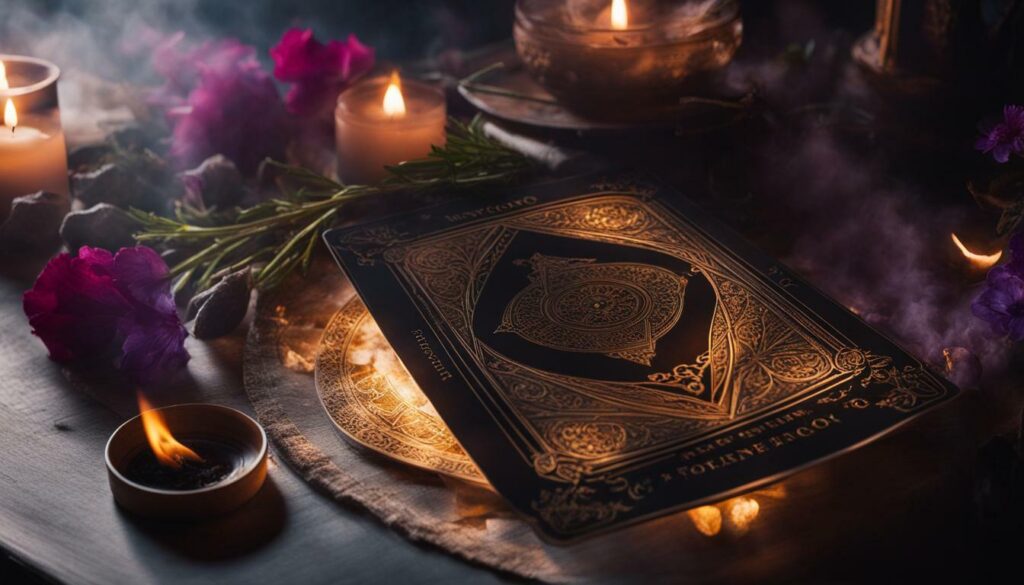
Summary
- Purifying your tarot deck is crucial to ensure accurate and untainted readings.
- Popular cleansing methods include using crystals, sage or palo santo, and moonlight.
- Crystals can be placed on or around your deck to absorb negative energies.
- Sage or palo santo can be used to pass sacred smoke over each card, clearing unwanted energies.
- Leaving your deck under the light of the full moon can cleanse and recharge its energy.
Exploring Different Tarot Decks and Styles
Tarot decks come in various styles and designs, each with its unique symbolism and energy. Choosing the right deck for yourself is crucial as it can greatly impact your tarot reading experience. Some popular decks include the Rider-Waite Smith deck and the Crowley-Harris Thoth deck, both known for their rich symbolism and deep spiritual insights.
The Rider-Waite Smith deck, created by Arthur Edward Waite and artist Pamela Colman Smith, is one of the most widely used tarot decks. It features vivid and intricate illustrations that represent the archetypal meanings of the cards. This deck is highly recommended for beginners due to its clarity and accessibility.
The Crowley-Harris Thoth deck, created by Aleister Crowley and artist Lady Frieda Harris, is known for its esoteric symbolism and occult influences. This deck delves into the depths of the human psyche and offers a more complex and thought-provoking interpretation of the tarot. It is a preferred choice for those seeking a deeper understanding of the cards and their mystical significance.
| Deck | Creator | Symbolism |
|---|---|---|
| Rider-Waite Smith | Arthur Edward Waite | Traditional, archetypal |
| Crowley-Harris Thoth | Aleister Crowley | Esoteric, occult |
When selecting a tarot deck, it’s essential to choose one that resonates with you personally. Take your time to explore different deck styles and designs, and pay attention to your intuition when making a decision. Trust your instincts and choose a deck that speaks to your soul, as this will deepen your connection with the cards and enhance the accuracy of your readings.
Remember, the tarot deck you choose is an extension of yourself and a powerful tool for self-discovery. Embrace the journey of exploring different tarot decks and styles, and trust that the right deck will find its way into your hands.
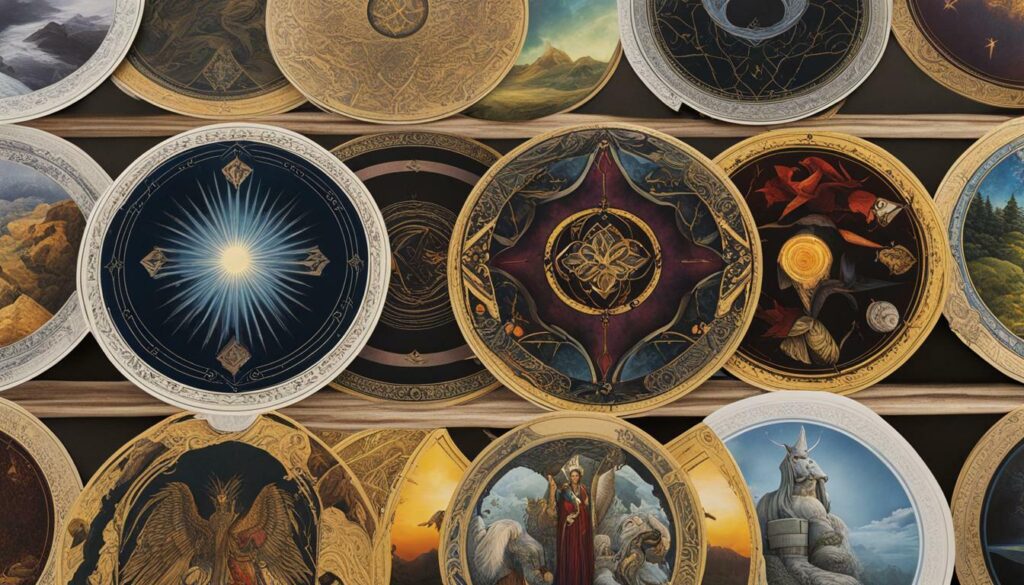
Reflecting on Your Tarot Readings: Insights and Guidance
Your tarot readings hold transformative potential – embrace the messages they convey and use them to enhance your personal growth and understanding. Each card drawn in a reading offers unique insights and guidance, providing a glimpse into the energies surrounding your current situation or question. As you reflect on your tarot readings, consider the following approaches to deepen your understanding and maximize the benefits of your practice.
Firstly, take your time to truly connect with the cards and their symbolism. Notice the colors, imagery, and emotions evoked by each card. Consider the connections between the cards drawn and their placement within the chosen spread. Allow yourself to intuitively explore the meanings and messages being revealed. Remember, there are no right or wrong interpretations – trust your intuition and personal connection to the cards.
To further enhance your tarot reading experience, keep a journal to record your insights and observations. Document each reading, including the question asked, the cards drawn, and your initial interpretations. As time passes, revisit your journal entries and reflect on the accuracy and relevance of the guidance received. Pay attention to recurring themes or patterns, as they may offer valuable insights into your life’s journey.
Lastly, consider seeking guidance from others or joining a tarot community. Engaging in discussions and sharing experiences with fellow tarot enthusiasts can expand your perspectives and deepen your understanding. Participate in online forums, attend workshops or tarot meetups, and exchange insights with like-minded individuals. Remember to be open-minded and respectful of different interpretations and approaches – diversity in perspectives can enrich your own tarot practice.
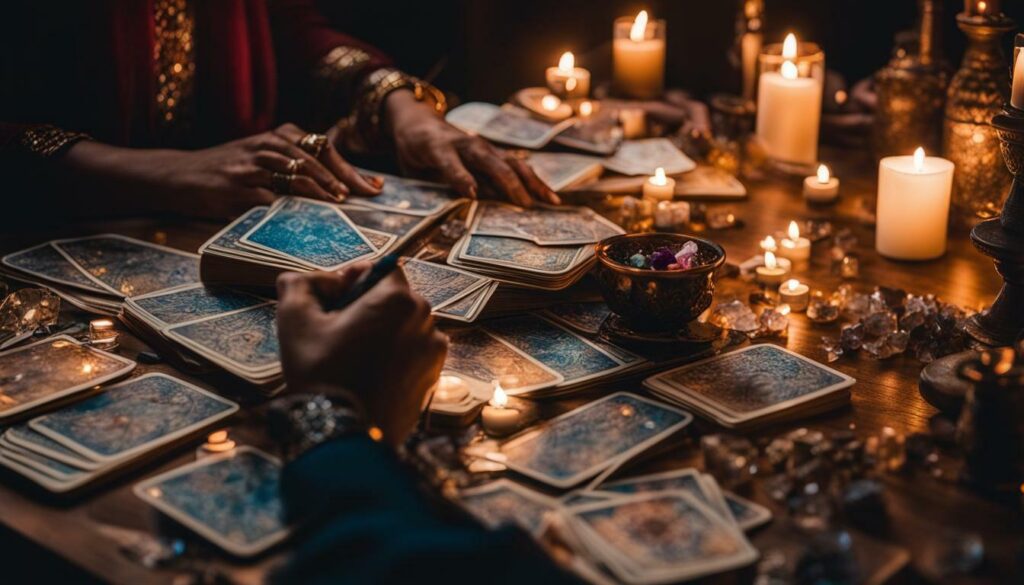
Final Thoughts
As you embark on your tarot reading journey, remember that the true power lies within you. The cards are tools that can guide and illuminate your path, but it is your intuition and connection to the divine that ultimately shape the messages they convey. Reflecting on your tarot readings allows you to tap into your inner wisdom and uncover hidden truths, providing guidance for personal growth and self-discovery. Embrace the transformative potential of tarot and embark on a journey of self-exploration, unraveling the mysteries that lie within the cards.
Concluding Your Tarot Reading Journey
Congratulations on embarking on your first tarot reading journey – remember to embrace the transformative power of the cards and enjoy the mysterious path they’ll take you on. Tarot reading is a powerful tool for self-discovery and guidance, and with a standard deck of 78 cards, you have a world of insights and wisdom at your fingertips.
As you dive into the world of tarot, familiarize yourself with the structure of a tarot deck. The major arcana cards represent major life events and themes, while the minor arcana cards relate to day-to-day challenges. Each card carries its own symbolism and meaning, so take the time to learn their significance and interpretations.
When it comes to reading tarot cards, there are various spreads you can use to gain insights. The one-card spread provides a quick snapshot of the situation, while the three-card spread offers a glimpse into the past, present, and future. For deeper insight, try the five-card spread, and for more complex readings, the Celtic cross spread is a popular choice.
Before starting your readings, it’s important to clear or cleanse your tarot deck. Utilize crystals, sage, or palo santo to remove any residual energies and create a clean slate for accurate readings. Additionally, explore different tarot decks with their unique styles and symbolism. The Rider-Waite Smith and Crowley-Harris Thoth decks are beloved classics that can provide a solid foundation for your tarot journey.
Remember, reading tarot cards is a personal and transformative experience. Set your intentions before each reading, connect with your intuition, and reflect on the messages the cards reveal. Trust your instincts and explore the mysteries that the tarot holds – you never know what insights and guidance await you on this enchanting path.
FAQ
Q: How do I start my first tarot reading?
A: To start your first tarot reading, you’ll need a tarot deck and a willingness to learn. Begin by familiarizing yourself with the structure of a standard tarot deck, which consists of 78 cards divided into the major arcana and minor arcana. There are different tarot spreads you can use, such as the one-card spread, the three-card spread, the five-card spread, and the Celtic cross spread. Choose a method that feels right for you, and rely on your intuition when pulling cards. It’s also recommended to clear or cleanse your tarot deck before use. Set your intention before a reading and reflect on the cards’ messages to gain insights and guidance.
Q: What are the basics of tarot reading?
A: Tarot reading involves using a deck of 78 cards to gain insights and guidance. The deck is divided into the major arcana, which represents major life events and themes, and the minor arcana, which relates to day-to-day challenges. The minor arcana consists of four suits: cups, wands, swords, and pentacles. Each card carries its own symbolism and meaning. Tarot readings can be done using various spreads, ranging from simple one-card readings to more complex Celtic cross spreads. It’s important to rely on your intuition and set your intention before a reading.
Q: How do I choose the right tarot deck for beginners?
A: Choosing the right tarot deck for beginners is a personal decision. It’s important to select a deck that resonates with you and speaks to your intuition. Popular beginner decks include the Rider-Waite Smith deck, which has clear and easily recognizable imagery, and the Crowley-Harris Thoth deck, which offers a deeper exploration of symbolism. Take the time to research different decks and explore their artwork and symbolism before making a choice.
Q: How can I understand the symbolism of tarot cards?
A: Understanding the symbolism of tarot cards takes time and practice. Each card carries its own unique symbolism and meaning. Begin by familiarizing yourself with the meanings of the cards, either through the guidebook that comes with your tarot deck or by using online resources. As you gain experience, you’ll start to develop your own interpretations based on the imagery and symbolism present in the cards. Trust your intuition and allow the cards to speak to you.
Q: How can I prepare for my first tarot reading?
A: To prepare for your first tarot reading, create a calm and sacred space where you can focus. Clear your mind and set your intention for the reading. Before using your tarot deck, it’s recommended to clear or cleanse it using crystals, sage, or palo santo. Take a few deep breaths and center yourself before beginning the reading.
Q: How can I get familiar with tarot card meanings?
A: Getting familiar with tarot card meanings is an important part of tarot reading. Start by studying the guidebook that comes with your tarot deck, as it will provide basic interpretations for each card. You can also find resources online, such as blogs, websites, and books, that offer more in-depth explanations of card meanings. Practice regularly by pulling cards and reflecting on their meanings. Over time, you’ll develop a deeper understanding of the cards and their individual symbolism.
Q: What are some common tarot spreads for beginners?
A: There are several common tarot spreads that beginners can use. The one-card spread is the simplest and provides insight into a specific question or situation. The three-card spread represents the past, present, and future, offering a broader perspective. The five-card spread provides deeper insight into a specific question or situation, while the Celtic cross spread is a more complex spread that gives a comprehensive overview of a person’s life. Experiment with different spreads to see which ones resonate with you the most.
Q: Can you give me a step-by-step tarot reading tutorial?
A: Certainly! Here is a step-by-step guide to conducting a tarot reading:
1. Clear and cleanse your tarot deck using crystals, sage, or palo santo.
2. Create a calm and sacred space for your reading.
3. Shuffle the deck while focusing on your intention or question.
4. Choose a spread that feels right for your reading (such as the one-card, three-card, or Celtic cross spread).
5. Lay out the cards in the chosen spread pattern.
6. Begin interpreting the cards based on their imagery, symbolism, and position in the spread.
7. Trust your intuition and allow the cards to guide you.
8. Reflect on the messages and insights gained from the reading.
9. Take notes or journal about your reading for future reference and reflection.
10. Thank the tarot deck and close your reading.
Remember, tarot reading is a personal and intuitive practice, so feel free to adapt this process to suit your own style and preferences.
Q: How do I cleanse and clear my tarot deck?
A: Cleansing and clearing your tarot deck is important to remove any energetic residue and establish a fresh connection. You can cleanse your deck by using crystals, such as clear quartz or selenite, and placing them on top of your deck overnight. You can also use sage or palo santo smoke to pass the deck through the smoke, envisioning it being cleansed. Trust your intuition and use a method that feels right for you.
Q: What are some different tarot decks and styles I can explore?
A: There are numerous tarot decks and styles to choose from. Popular decks include the Rider-Waite Smith deck, which features traditional imagery and symbolism, and the Crowley-Harris Thoth deck, which offers a more esoteric and complex approach. Other decks may have unique themes, such as animal, fantasy, or nature-based decks. Explore different decks and styles to find one that resonates with you and speaks to your intuition.
Q: How can I reflect on my tarot readings for insights and guidance?
A: Reflecting on your tarot readings is an important part of gaining insights and guidance. Before each reading, set your intention and focus on the question or situation you want guidance on. After the reading, take time to journal about the cards you pulled, the meanings you derived from them, and any intuitive insights or messages you received. Consider how the cards relate to your life and the guidance they offer. Trust your intuition and allow the cards to guide you on your journey.
